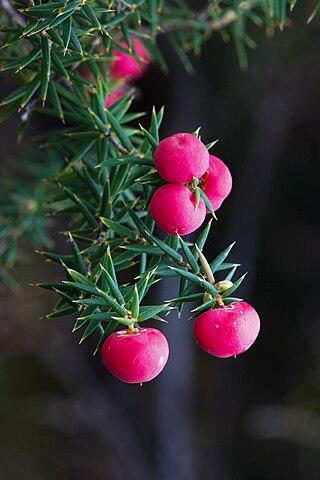
The Ericaceae are a family of flowering plants, commonly known as the heath or heather family, found most commonly in acidic and infertile growing conditions. The family is large, with c. 4250 known species spread across 124 genera, making it the 14th most species-rich family of flowering plants. The many well known and economically important members of the Ericaceae include the cranberry, blueberry, huckleberry, rhododendron, and various common heaths and heathers.

Rhododendron is a very large genus of about 1,024 species of woody plants in the heath family (Ericaceae). They can be either evergreen or deciduous. Most species are native to eastern Asia and the Himalayan region, but smaller numbers occur elsewhere in Asia, and in North America, Europe and Australia.

In biology, a subgenus is a taxonomic rank directly below genus.

Abies sibirica, the Siberian fir, is a coniferous evergreen tree native to the taiga east of the Volga River and south of 67°40' North latitude in Siberia through Turkestan, northeast Xinjiang, Mongolia and Heilongjiang.
Sydowia polyspora is a plant pathogen infecting Douglas firs. In Iceland, it has been reported to infect Larix russica, Pinus contorta and Pinus mugo. and on Rhododendron indicum.

The Dothioraceae are a family of fungi in the order Dothideales. Species in this family have a widespread distribution, and are biotrophic or necrotrophic, usually associated with woody plants.
Bertiella is a genus of fungi in the family Teichosporaceae. although Wijayawardene et al. 2020 places it within the Melanommataceae family.

Muellerella is a genus of lichenicolous lichens in the family Verrucariaceae. The genus has a widespread distribution, especially in northern temperate areas, and contains species that live on other lichens, or on liverworts.
Barrina is a genus of fungi within the class Sordariomycetes. This genus was named after mycologist Margaret E. Barr. A monotypic genus, Barrina contains the single species Barrina polyspora, described as new to science in 1997.
Lembosiella is a genus of fungi in the Microthyriaceae family; according to the 2007 Outline of Ascomycota, the placement in this family is uncertain. This is a monotypic genus, containing the single species Lembosiella polyspora.
Psorotichia is a genus of lichen-forming fungi in the family Lichinaceae. The genus was circumscribed by Italian lichenologist Abramo Bartolommeo Massalongo in 1855, with Psorotichia murorum assigned as the type species.
Tylophorella is a genus of lichen-forming fungi in the order Arthoniales. The genus has not been placed into a family. Tylophorella was circumscribed by Finnish lichenologist Edvard August Vainio in 1890, with Tylophorella polyspora assigned as the type species. T. pyrenocarpoides was added to the genus in 1993.

Kalmia procumbens, commonly known as alpine azalea or trailing azalea, is a dwarf shrub of high mountain regions of the Northern Hemisphere that usually grows no more than 10 centimeters (4 in) tall. Originally named by Linnaeus as Azalea procumbens, it is also named after French botanist L.L.A. Loiseleur-Deslongchamps - Loiseleuria procumbens.

Rhododendron columbianum, commonly known as western Labrador tea, swamp tea, or muskeg tea, is a shrub that is widespread in the western United States and in western Canada, reported from British Columbia, Alberta, Washington, Oregon, Idaho, California, Montana, Wyoming, Utah, Nevada, and Colorado. It grows in wet places from sea level up to 3,500 m (11,000 ft). It was formerly known as Ledum columbianum. Its origins date back to the late Pliocene.
Amalgaviridae is a family of double-stranded RNA viruses. Member viruses infect plants and are transmitted vertically via seeds. The name derives from amalgam which refers to amalgaviruses possessing characteristics of both partitiviruses and totiviruses. There are ten species in the family.
Lipocystis is a genus of parasitic alveolates of the phylum Apicomplexa.

Sarcoporia is a genus of polypore fungi in the family Polyporaceae. The genus was circumscribed by Petter Karsten in 1894, with the widespread fungus Sarcoporia polyspora as the type species. The genus name combines the Ancient Greek words σάρξ ("flesh") and πόρος ("pore").
Kabatiella is a genus of fungi belonging to the family Saccotheciaceae.
Delphinella is a genus of fungi belonging to the family Dothioraceae.
Delphinella balsameae is a species of fungus in the family Dothioraceae. It is a known plant pathogen, reported to cause blight in Siberian fir in Russia, balsam fir, white fir and subalpine fir in North-America.








